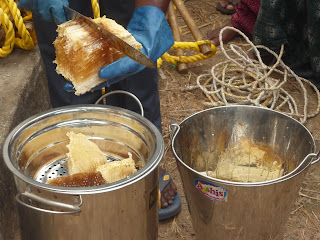 |
| SST Animator demonstrates honey collection |
We park our car on the hillside and pack up our provisions. It is still another 3km descent on foot into the hill valley where monkeys and wild elephants are known to live. Today we are accompanying Baskar, an MSW and SST community developer. Baskar has been partnering with “community animators” – village residents who act as liaisons between SST and targeted communities—to promote improved honey collection techniques through awareness and training. Yesterday Baskar explained the new method and today we have come to observe whether village residents can practically apply the information. The men put on the bee suits correctly, collect the comb, and extract a half-liter’s worth of pure honey. But still I question whether the community will continue practicing this new technique when the equipment isn’t new anymore and they no longer have an audience. The village took part in an agriculture training several months back but still the majority of millet fields are not spaced properly. Will something similar happen with this training?
SST staff tells me that progress in the plains communities is easier and faster than in the tribal areas. Why is this the case? As a student trained in ecosystems theory I am aware that the reasons are multiple and complex. Relationship-processes happening across generations and system levels have contributed to tribal communities’ structural and social isolation, suspicion of outsiders, and hesitancy when it comes to accepting development schemes. I spend my days here trying to understand these relationship-processes and how SST enters into them. Using a strengths-perspective I think about how farmers are not acting irrationally or stupidly by refusing to readily adopt new development schemes. Rather, they are exercising the highest prudence and risk-management. Why would a poor farmer, who has everything to lose, invest in something that he is not absolutely sure will be profitable? It is natural to want someone else to try it first.
The onus is not on the farmer but on the developing agency to find effective strategies to help communities discover for themselves whether technique X or scheme Y is worth doing, despite the risk. But what makes a strategy effective? Trust—in the message or the messenger—is a definite ingredient. So I observe the animators, studying what makes them effective community organizers. Going back to social work basics I try to see if and how the three facilitative conditions of the therapeutic working relationship—empathy, authenticity, and positive regard—are employed in this context. Is there a way to improve the working relationship here so that change occurs faster?
 |
| Jadhavu Hills, Tamil Nadu |
No comments:
Post a Comment